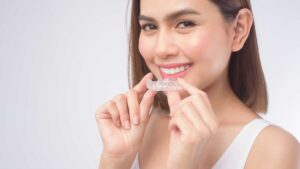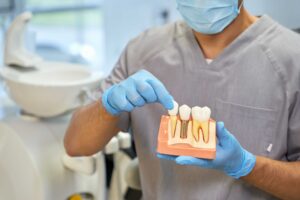What Are Invisalign Aligners?
Invisalign aligners are a modern orthodontic treatment designed to discreetly and gradually align teeth. Unlike traditional metal braces, Invisalign aligners are made from clear, BPA-free plastic material. Their transparency allows wearers to maintain their natural appearance throughout the treatment process. These aligners are custom-made for each patient, ensuring a precise fit and effective alignment.
Invisalign aligners are an evolution of traditional braces, offering a more inconspicuous way to achieve a straighter smile. The clear plastic material makes them virtually invisible, allowing patients to go about their daily lives without feeling self-conscious about their orthodontic treatment. The aligners are designed to apply controlled and gradual pressure on specific teeth, gently nudging them into their desired positions over time.
How Invisalign Aligners Work: Step-by-Step Process
Initial Consultation
The journey to a straighter smile begins with an initial consultation with an experienced orthodontist. During this consultation, a 3D digital scan of the patient’s teeth is taken, eliminating the need for messy and uncomfortable impressions. This cutting-edge technology allows orthodontists to create accurate and detailed models of the patient’s teeth, which serve as the foundation for creating the custom aligners.
Treatment Plan and Custom Aligners
Based on the 3D models of the patient’s teeth, the orthodontist develops a personalized treatment plan. This plan outlines the gradual movement of the teeth and the expected results at each stage. Custom aligners are then fabricated using advanced technology to ensure a perfect fit for the patient. These aligners are designed to fit snugly over the teeth, applying the right amount of pressure to guide the teeth into alignment.
Changing Aligners
Patients receive a series of aligners, each representing a different stage of tooth movement. The aligners are changed every one to two weeks, with each set designed to make incremental adjustments to the teeth’s position. This step-by-step progression is crucial for achieving the desired alignment while maintaining patient comfort. As patients progress through the series of aligners, they will notice their teeth gradually moving closer to their ideal positions.
Monitoring Progress
Through virtual tools, orthodontists can monitor the progress of the treatment remotely. This technology allows for timely adjustments and ensures that the treatment is proceeding according to plan. In some cases, mid-course corrections might be required to fine-tune the results. Regular check-ins with the orthodontist help ensure that the treatment is on track and adjustments are made if necessary.
Invisalign's Functional Benefits: Why Choose It?
The decision to opt for Invisalign aligners goes beyond just cosmetic considerations. Several functional benefits make Invisalign an attractive choice:
Aesthetics and Discretion
The clear and transparent nature of Invisalign aligners means that wearers can confidently smile without the self-consciousness often associated with traditional braces. Whether at work, social gatherings, or special occasions, Invisalign aligners offer a discreet way to enhance your smile without drawing attention to your orthodontic treatment.
Removability for Eating and Drinking
Unlike traditional braces, Invisalign aligners can be easily removed for eating and drinking. This means no restrictions on diet and no concerns about food getting stuck in brackets. Patients can enjoy their favorite foods without worrying about damaging their orthodontic appliances.
Reduced Discomfort and Fewer Adjustments
Invisalign aligners exert gentle pressure on the teeth, resulting in reduced discomfort compared to the tightening of traditional braces. Additionally, the need for frequent adjustments is eliminated. Patients can simply move on to the next set of aligners in their series, reducing the need for in-office visits solely for adjustments.
Customized Treatment for Comfort
Each set of Invisalign aligners is designed based on the patient’s treatment plan, ensuring a comfortable fit that minimizes irritation and soreness. The aligners are smooth and made from a comfortable plastic material, making them easy to wear throughout the day.
Achieving a Proper Fit: Ensuring Effectiveness
Precise Fit and Comfort
Invisalign aligners are crafted using advanced technology to ensure a precise fit. This fit is essential for facilitating the controlled movement of teeth throughout the treatment process. Orthodontists take precise measurements and create 3D models to ensure that each aligner fits the patient’s teeth perfectly.
Eating and Oral Hygiene
Invisalign aligners can be easily removed before meals, allowing patients to enjoy their favorite foods without worry. Additionally, maintaining oral hygiene is straightforward, as brushing and flossing can be performed without the interference of brackets and wires. Patients should remove their aligners before eating and clean both their teeth and aligners before reinserting them.
Speech Considerations
Some patients may experience a slight adjustment period when speaking with the aligners in place. However, with time, this adaptation becomes natural, and speech returns to normal. The aligners may feel slightly different at first, but as patients become accustomed to wearing them, any initial speech concerns tend to diminish.
Candidacy and Considerations for Invisalign Treatment
Invisalign aligners are suitable for a wide range of orthodontic issues, including mild to moderate crowding, spacing, and bite issues. Ideal candidates are committed to wearing aligners as directed by the orthodontist, ensuring the best possible outcome. It’s important to note that more complex cases may still require traditional braces. During the initial consultation, the orthodontist will assess the patient’s dental condition and determine whether Invisalign is the right choice.
After Invisalign: Retention and Follow-Up
Upon completing the Invisalign treatment, patients are provided with retainers. Retainers help maintain the newly achieved alignment, preventing teeth from shifting back to their original positions. Regular follow-up appointments with the orthodontist are necessary to monitor the results and make any necessary adjustments. Patients will typically wear retainers as instructed by the orthodontist to ensure the longevity of their results.
Frequently Asked Questions (FAQs)
Improve Your Oral Health With Hedgecock Dental
Hedgecock Dental is available for all of your family dentistry needs. Our dental office in Austin, TX provides general, sedation, restorative and cosmetic dentistry to patients of all ages.
Are Invisalign aligners painful to wear?
Invisalign aligners are designed to exert gentle pressure on the teeth, which may cause some discomfort initially. However, this discomfort is usually mild and temporary, as the aligners gradually shift the teeth into alignment.
Can I remove Invisalign aligners for special occasions?
Yes, Invisalign aligners are removable, allowing you to take them out for special occasions. However, it’s important to wear them for the recommended amount of time each day to achieve optimal results.
How often do I need to change my aligners?
Aligners are typically changed every one to two weeks, as specified by your orthodontist. Each new set of aligners will gradually move your teeth closer to their desired positions.
Can I eat and drink with Invisalign aligners in place?
It’s recommended to remove your aligners before eating or drinking anything other than water. This helps prevent staining and damage to the aligners. Remember to brush your teeth before reinserting them.
Will wearing Invisalign aligners affect my speech?
Some patients may experience a slight adjustment period when speaking with the aligners in place. This adjustment is temporary, and most people adapt quickly, with their speech returning to normal.
How long will I need to wear retainers after Invisalign treatment?
Retainer wear varies from patient to patient and is typically recommended for a certain period to maintain the achieved alignment. Your orthodontist will provide guidance on how long to wear your retainers.





